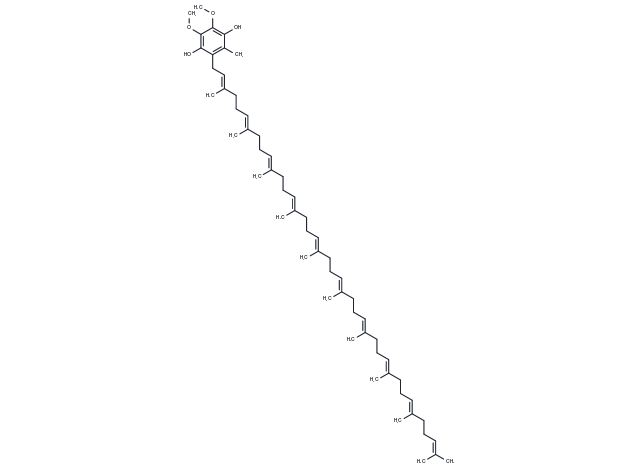Powder: -20°C for 3 years | In solvent: -80°C for 1 year


Ubiquinol is a reduced form of coenzyme Q10 (CoQ10) and is a potent antioxidant that has the capacity to protect Vitamin E.

| Pack Size | Availability | Price/USD | Quantity |
|---|---|---|---|
| 500 μg | 35 days | $ 296.00 | |
| 1 mg | 35 days | $ 545.00 | |
| 5 mg | 35 days | $ 2,400.00 | |
| 10 mg | 35 days | $ 4,200.00 |
| Description | Ubiquinol is a reduced form of coenzyme Q10 (CoQ10) and is a potent antioxidant that has the capacity to protect Vitamin E. |
| In vitro | The lipophilic environment encircles the lipophilic low-molecular-weight antioxidants (α-tocopherol, β-carotene, and Ubiquinol) and prevents them from reacting as skin protectors[1]. |
| In vivo | The levels of these homologues are highest in heart with lesser amounts occurring in kidney, liver and other organs. In liver and blood plasma, the UQred homologue amounted to 70-80% of the total UQ (UQox + Ubiquinol = t-UQ). Ubiquinol is less than 30% of t-UQ in other tissues and blood cells. t-UQ is much higher in leukocytes and platelets in blood than in erythrocytes. In erythrocytes, t-UQ is exclusively located in the cell membranes.Ubiquinol is also found in all subcellular components isolated from the liver and kidney, and its ratio is approximately the same as the ratio of ubiquinol/t-UQ in the entire organ. The levels of Ubiquinol per mg protein in subcellular fractions from liver is highest in mitochondria, with lesser amounts present in plasma membranes, lysosomes, Golgi complex, nuclei, microsomes and cytosol. In the mitochondria, the outer membranes are richer in t-UQ than the inner membranes[4]. |
| Synonyms | Ubiquinol-10, CoQH2-10 |
| Molecular Weight | 865.381 |
| Formula | C59H92O4 |
| CAS No. | 992-78-9 |
Powder: -20°C for 3 years | In solvent: -80°C for 1 year
You can also refer to dose conversion for different animals. More
bottom
Please see Inhibitor Handling Instructions for more frequently ask questions. Topics include: how to prepare stock solutions, how to store products, and cautions on cell-based assays & animal experiments, etc.
Ubiquinol 992-78-9 Others Ubiquinol-10 CoQH2-10 inhibitor inhibit
